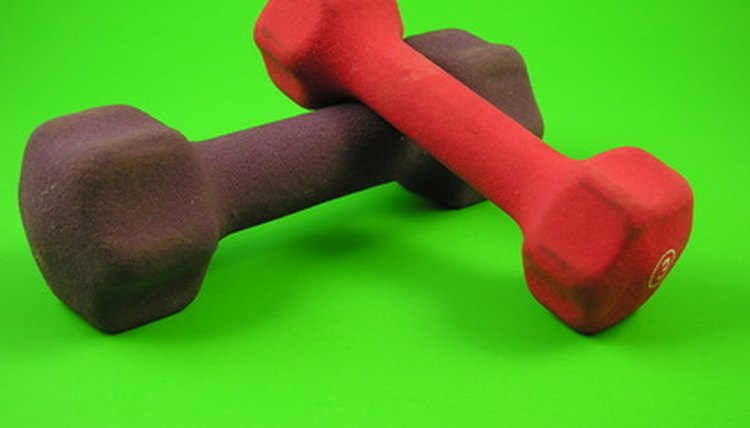What Are the Benefits of Walking With Hand Weights?

Walking is one of the simplest, cheapest and safest forms of exercise, offering a number of important health gains, according to the American Heart Association. Whether you partake in leisurely walking or speed walking, the beneficial effect of walking can be improved by adding hand weights to your walking routine. Adding hand weights to your walk is an easy transition because the size of weight used and the amount of arm movement can be varied to meet your individual fitness level.
Increase Calorie Burn
Carrying hand weights while walking allows you to work your upper body more intensely than walking without them. By recruiting muscles in your lower body as well as your upper body, the intensity of your workout is increased, thereby increasing the amount of calories burned per minute.
By carrying hand weights, you increase the amount of weight your body must move through space. Because it takes more energy to move more weight, making yourself heavier by adding hand weights to your walking routine causes your body to burn more calories in order to move.
Improved Muscular Strength and Endurance
Walking without weights does nothing to tax the muscles of the upper body. Adding hand weights to your workout, however, will help to improve muscular strength and endurance of the both the upper and lower body. Whether you merely carry the hand weights or actually perform resistance moves such as biceps curls during your walk, you will benefit from increased muscle fitness. The mere act of carrying the weights will force your muscles to maintain a static contraction. When you deliberately move your arms, you are creating dynamic movements, which improve your arm muscles even more.
Your lower body also benefits from carrying hand weights, in that they increase the total weight your legs must bear. This extra weight will force the muscles of the lower body to work harder, resulting in improved muscular strength and endurance.
Save Time
Walking with hand weights allows you to multitask, thereby saving valuable time. By combining weight training with cardiovascular exercise, you are getting a multifaceted workout in the time it takes you to perform one. Walking without weights offers cardio and lower body benefits, but your arms get little benefit. When using hand weights, however, you are able to strengthen the muscles in your arms and tone your legs while engaging in sustained cardio exercise.
References
- Dames KD, Smith JD. Effects of load carriage and footwear on lower extremity kinetics and kinematics during overground walking. Gait Posture. 2016;50:207-211. doi:10.1016/j.gaitpost.2016.09.012
- Harvard Health Publishing. Wearable weights: How they can help or hurt. May 2018.
- Koo HM, Lee SY. Gait analysis on the condition of arm swing in healthy young adults. Physical Therapy Rehabilitation Science. 2016;5:149-54. doi:10.14474/ptrs.2016.5.3.149
- Chwała W, Klimek A, Mirek W. Changes in energy cost and total external work of muscles in elite race walkers walking at different speeds. J Hum Kinet. 2014;44:129-36. doi:10.2478/hukin-2014-0118
- Sugiyama K, Kawamura M, Tomita H, Katamoto S. Oxygen uptake, heart rate, perceived exertion, and integrated electromyogram of the lower and upper extremities during level and Nordic walking on a treadmill. Journal of Physiological Anthropology. 2013;32(1):2. doi:10.1186/1880-6805-32-2.
- Ainsworth BE, Haskell WL, Herrmann SD, et al. 2011 Compendium of Physical Activities. Medicine & Science in Sports & Exercise. 2011;43(8):1575-1581. doi:10.1249/mss.0b013e31821ece12
- Dames KD, Smith JD. Effects of load carriage and footwear on lower extremity kinetics and kinematics during overground walking. Gait Posture. 2015 oct;50:207-211. doi: 10.1016/j.gaitpost.2016.09.012.
Writer Bio
Jen Weir writes for several websites, specializing in the health and fitness field. She holds a Bachelor of Science in exercise science from Montana State University, is an NSCA-certified strength and conditioning specialist and maintains a personal trainer certification from the American College of Sports Medicine.
